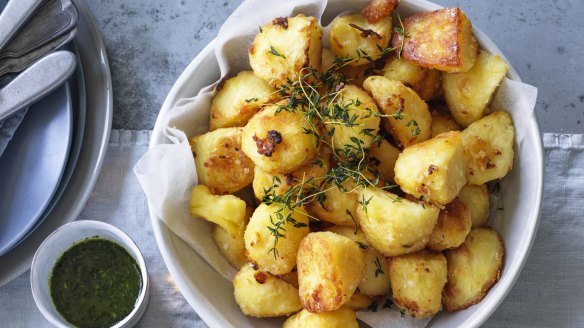Are you paying for dirt when you buy brushed potatoes?

Brushed potatoes. Am I paying good money for a layer of dirt? A. Hassan
Potatoes survive long after harvest. They are part of the plant's reproductive strategy and, as such, remain alive until you peel and cook them, or when they fall behind the bottom drawer in the pantry and rot silently. If exposed to light, however, the potatoes know (not that potatoes are sentient, as far as we know) that they have been removed from the soil. As a response, the potatoes produce chlorophyll, which turns them green. As a defensive measure they also produce compounds called glycoalkaloids, which are toxic to many creatures, including us. That said, you would need an entire kilogram of green potatoes to become ill. That layer of dirt they were grown in acts as a protective barrier to light. If you grow your own potatoes, don't wash them before storage. Soak brushed potatoes in water before scrubbing clean.
The rosemary on my baked potatoes is burning. G. Edwards
Try fresh rosemary. If you need to use dried rosemary, soak in a little warm water half an hour beforehand.
I recently bought a fresh supply of cornflour. The box was clearly labelled "made from wheat". Would this be considered gluten-free? J. Ross
Cornflour is a quite pure form of starch. Despite the name, it can be made from either wheat or corn (maize) kernels, and the two types are interchangeable in recipes (American recipes call the ingredient "cornstarch"). The protein and other parts of the flour are mostly removed, leaving a fine white powder that is suitable for thickening dishes. However, only cornflour made from maize is gluten-free. Check the ingredients and look for the gluten-free logo.
My fish fillets ooze white stuff that looks like egg white when they're cooked. D. Kozacski
You really nailed the description of the white ooze that congeals when cooked. This is albumen, a protein common to both fish and egg whites. As the fish cooks, the muscles contract, squeezing moisture from the fibres, and this moisture contains albumen. When the moisture hits the hot pan or hot air in the oven, it solidifies. The situation is exacerbated when fish is cooked very quickly on high heat, has been frozen poorly, or has been sitting around in the refrigerator for a few days. It is edible, if unsightly. If it concerns you, conceal the fish with a little sauce made by deglazing the cooking pan with a little white wine, adding a few tablespoons of butter, some capers and finely chopped parsley, perhaps a hint of fine lemon zest, and allow the sauce to thicken for a few minutes before pouring over the fish.
Letters
We get a lot of mail here at the Brain Food Institute. Although I did not feel equipped to answer this query, it did pique my very particular sense of quirk. D. Woodman wrote, "I was cooking some pasta the other day, and had leftovers from two different sized penne packets. When I'd finished cooking the pasta, I was surprised to see that the smaller penne had all slipped inside, the larger penne." Well, I never!
Send your vexing culinary conundrums to brainfood@richardcornish.com.au or tweet to @realbrainfood.
Appears in these collections
- More:
- Food
- Brain food
